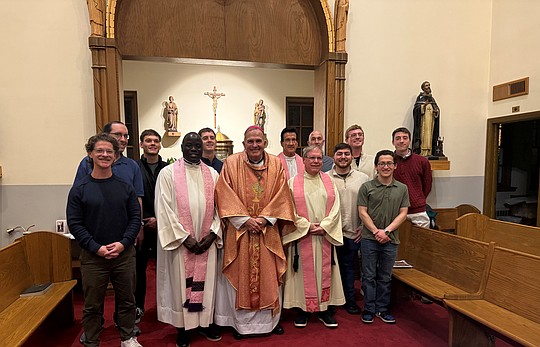Faith at Home: Living our faith through charity
April 11, 2025 at 12:00 a.m.

There are some words in our language which, when inspected more closely, contain a depth of meaning of which most of us may be unaware. One such word is “charity.”
A few years ago, I taught a fourth-grade class in our religious education program and asked the students what “charity” meant to them. Their answers were, I think, similar to what most people would say. They agreed that it means doing something good for someone less fortunate. And they were correct! However, that is just one expression of this virtue. When we began to examine the word through a Catholic lens, we found there was much more to it.
For us as Catholics, the definition of charity is rich with meaning, and that meaning is rooted in our relationship with God. The Catechism defines charity as being “the theological virtue by which we love God above all things for his own sake, and our neighbor as ourselves for the love of God.” This is a selfless love which inspires us to want to care for others and motivates us to want to be of service.
This desire to serve and to do good seems to come naturally to young people. Adults – parents, family members, catechists, friends – have a special call to encourage, nurture, and guide children in this area. Here are a few practical ways we can do this:
Seek out service opportunities you can work on as a family or create your own family service project. This can begin by discussing with children what needs they see in their community, and brainstorming ways they might be able to help.
Serving as a family can be particularly helpful because many organizations have age requirements for volunteering, but some will allow a child to volunteer if accompanied by a parent. Creating your own family service project can also allow children to be more directly involved, especially if they have input in the planning.
Talk with children about the importance of the dignity of those you are serving. We see good deeds celebrated often on social media, but the act is compromised when the recipient’s identity is revealed, and/or when the person’s feelings about being in need and receiving help aren’t taken into consideration. Children, who are “digital natives” born into the age of social media, must be gently guided by adults in this area. Explaining that part of serving others means thinking about the feelings of the other person, and caring for the dignity of our brothers and sisters in need who accept help from others.
Connect your service with your faith. Our faith is meant to be lived. Service is a truly wonderful way to live one’s faith, because it allows us to follow the example of Jesus, who “did not come to be served but to serve.” Highlight saints whose stories or words might be relatable and inspiring to children. St. Therese of Lisieux’s teaching that there is great value in doing little things with love is an example. Blessed Carlo Acutis, who will be canonized April 27, was a young person who used his gifts of faith and knowledge of technology to serve others and is also a wonderful role model for living the virtue of charity.
By nourishing these seeds of charity in our children, we are not only helping to form them as good Christian Catholics but also to form the future of their world into a place of greater love and peace.
St. Paul recognized how powerfully transformative and essential the virtue is, and he teaches us very simply and profoundly in this treasured passage from Corinthians: “So faith, hope, love remain, these three; but the greatest of these is love.”
Jessica Donohue is the parish catechetical leader in St. Joan of Arc Parish, Marlton.
Faith at Home is a monthly column coordinated by the Diocese of Trenton’s Departments of Catechesis, Evangelization and Family Life, and Youth and Young Adult Ministry. For additional Faith at Home resources, visit dioceseoftrenton.org/faith-at-home.
Related Stories
Monday, December 15, 2025
E-Editions
Events
There are some words in our language which, when inspected more closely, contain a depth of meaning of which most of us may be unaware. One such word is “charity.”
A few years ago, I taught a fourth-grade class in our religious education program and asked the students what “charity” meant to them. Their answers were, I think, similar to what most people would say. They agreed that it means doing something good for someone less fortunate. And they were correct! However, that is just one expression of this virtue. When we began to examine the word through a Catholic lens, we found there was much more to it.
For us as Catholics, the definition of charity is rich with meaning, and that meaning is rooted in our relationship with God. The Catechism defines charity as being “the theological virtue by which we love God above all things for his own sake, and our neighbor as ourselves for the love of God.” This is a selfless love which inspires us to want to care for others and motivates us to want to be of service.
This desire to serve and to do good seems to come naturally to young people. Adults – parents, family members, catechists, friends – have a special call to encourage, nurture, and guide children in this area. Here are a few practical ways we can do this:
Seek out service opportunities you can work on as a family or create your own family service project. This can begin by discussing with children what needs they see in their community, and brainstorming ways they might be able to help.
Serving as a family can be particularly helpful because many organizations have age requirements for volunteering, but some will allow a child to volunteer if accompanied by a parent. Creating your own family service project can also allow children to be more directly involved, especially if they have input in the planning.
Talk with children about the importance of the dignity of those you are serving. We see good deeds celebrated often on social media, but the act is compromised when the recipient’s identity is revealed, and/or when the person’s feelings about being in need and receiving help aren’t taken into consideration. Children, who are “digital natives” born into the age of social media, must be gently guided by adults in this area. Explaining that part of serving others means thinking about the feelings of the other person, and caring for the dignity of our brothers and sisters in need who accept help from others.
Connect your service with your faith. Our faith is meant to be lived. Service is a truly wonderful way to live one’s faith, because it allows us to follow the example of Jesus, who “did not come to be served but to serve.” Highlight saints whose stories or words might be relatable and inspiring to children. St. Therese of Lisieux’s teaching that there is great value in doing little things with love is an example. Blessed Carlo Acutis, who will be canonized April 27, was a young person who used his gifts of faith and knowledge of technology to serve others and is also a wonderful role model for living the virtue of charity.
By nourishing these seeds of charity in our children, we are not only helping to form them as good Christian Catholics but also to form the future of their world into a place of greater love and peace.
St. Paul recognized how powerfully transformative and essential the virtue is, and he teaches us very simply and profoundly in this treasured passage from Corinthians: “So faith, hope, love remain, these three; but the greatest of these is love.”
Jessica Donohue is the parish catechetical leader in St. Joan of Arc Parish, Marlton.
Faith at Home is a monthly column coordinated by the Diocese of Trenton’s Departments of Catechesis, Evangelization and Family Life, and Youth and Young Adult Ministry. For additional Faith at Home resources, visit dioceseoftrenton.org/faith-at-home.










